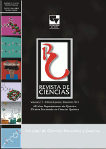Review of Recent Developments and Shortcomings in the Characterization of Potential Atmospheric Ice Nuclei: Focus on the Tropics
Contenido principal del artículo
In this paper, we summarize the four main ice nucleating aerosol types: mineral dusts, bioaerosols, soot, and glassy organics, with the aim of demonstrating the limitations in scientific literature regarding their ice nucleation properties. Because the tropics are largely associated with marine environments, such as the Atlantic, Pacifi c, and Indian Oceans, they are potential source of ice nuclei, and therefore ice clouds can form in regions of high convective uplift. As a result, these particles are able to infl uence both the planet’s radiative force and its hydrological cycle. Due to our limited understanding of these effects, we would like to encourage the scientifi c community to increase its efforts to study and characterize the tropical aerosol particles that may function as ice nuclei. Through such efforts, we may reduce uncertainties in climate predictions, and improve our understanding of global warming in the hopes of fi nding potential solutions to these issues.

Esta obra está bajo una licencia internacional Creative Commons Atribución-NoComercial-CompartirIgual 4.0.





